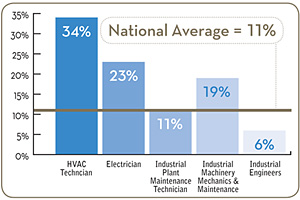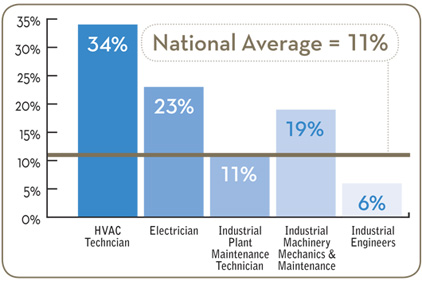
|
| Forecasted annual job growth, according to the Bureau of Labor Statistics’ Occupational Outlook Handbook 2012-2013. |
While the number of HVAC technician jobs continues to grow exponentially, Fluke Corp. has found a considerable gap between the number of candidates needed for those jobs and those who are qualified to do them.
In its 2012 Workforce Trends survey — which polled 1,608 industry professionals, educators, and employers — Fluke reported that 85 percent of employers found it difficult or very difficult to find entry-level workers with acceptable skills.
“We felt the data showed there was not enough mentoring and continuous training happening in the field,” said Leah Friberg, public relations manager for Fluke. “There still wasn’t enough hands-on training, which translated to a significant gap in the number of qualified workers.”
A Look at the Numbers
According to the U.S. Bureau of Labor Statistics Occupational Outlook Handbook 2012-2013, the number of HVAC technician jobs is forecast to grow at a rate of 34 percent — triple the national average of 11 percent. In fact, Air-Conditioning, Heating & Refrigeration Institute (AHRI) director of education, Warren Lupson, said the HVAC industry will need 27,000 new workers each year just to replace those who are retiring.
But Fluke’s survey also showed many of those entering the workforce simply do not have the skills or experience employers expect and want. “We saw a need for more internships and apprenticeships in a rotational format,” Friberg said, adding that, as more and more buildings upgrade to newer equipment, hands-on training is needed more than ever in order to be able to work on the more complicated systems.
In the survey, 38 percent of employers said candidates lacked an applicable degree or certification, and 53 percent said they lacked on-the-job experience, with the average minimum required experience expected at 3.4 years.
But while employers say HVAC job candidates are ill prepared out of school, 95 percent of educators and trainers surveyed said students that graduated from their programs possessed enough skill using electrical tools to meet entry-level qualifications.
The Blame Game
So, who is responsible for the gap between what candidates know how to do and what employers expect them to be able to do? The answer is not clean-cut, Friberg said, but there are things both educators and employers can do to help close the gap.
To help get the tools themselves into students’ hands, Fluke offers tubs of test tools with a sample set-up, Friberg said. For just the cost of shipping, educators can check out the tubs and let students use them to gain practical skills through hands-on training. Fluke also offers a 25 percent discount to educators on all of its tools, and a student discount “helps students get the right tools at the beginning,” Friberg said.
For those training programs that can prove economic hardship, Friberg said Fluke will sometimes donate tools with which students can practice. “We try to work with the nonprofit associations,” Friberg said.
Howard Weiss, marketing director for HVAC Excellence, said both educators and employers need to step up to provide more hands-on training for students.
“If you’re going to a full-time day program, it’s between 800 and 1,100 hours,” Weiss said. “In 800 hours, can I train someone? Contractors want them to be van-ready, but that’s not going to happen.”
Weiss said schools, in just a couple of years, simply don’t have the time to teach technicians everything their future employers expect them to know. “What you can teach them is the fundamentals, and we need to teach them troubleshooting,” he added.
How Employers Can Help
The way to bridge the gap between students’ training and employers’ expectations, Weiss said, lies, in part, in the hands of the educators. “A program is only as good as the quality of the instructor,” he said. “If you have the wrong person running the program, the students won’t learn anything.”
Just as important, however, is employer involvement in local schools. Expecting potential employees to have a certain competence upon leaving school, but not contributing to that competence or making your expectations known, simply does not make sense, Weiss said. Employers need to take a more active role in their potential employees’ education.
“Get involved,” Weiss said. “Go visit your local trade school. They’re required to have an advisory meeting twice a year where they’ll tell you about what they’re doing and give you a tour. Then they ask you specifically what they’re not doing.”
That opportunity to give input can help shape the program, Weiss said, which can result in students coming out of school with the skills a future employer desires. Employers can also go one step further by donating equipment to local programs. “If you’re pulling equipment out of a house or building, you can donate it,” Weiss said. He added, “The opportunity is there, and what contractors need to understand is what they’re being taught, and what they’re not being taught, and then work with the schools.”
The Next Generation
More helpful than all of that, though, is simply getting the next generation of HVAC technicians interested in those careers. With the industry growing so rapidly, and with the baby boomer generation sliding into retirement at an increasingly rapid pace, finding enough students to take their place in the industry may prove a challenge in itself.
“More than 65 percent of the people who will be in the HVAC industry in 2020 are not in it in 2010, and contractors can take a preemptive strike by going into high schools and trying to recruit students,” Weiss said. “I think people misunderstand what this industry is and what you can make.”
Concentrating on the future generation of HVAC employees, Weiss said, could also be the key to fixing a lot of the problems facing the industry now.
“Maybe this is an opportunity to train the next generation even better,” he said. “About 72 percent of residential systems are improperly sized, 68 percent are improperly charged, 70 percent have improper airflow, and 91 percent have never had a combustion analysis check. What does that mean? If you’re a consumer, you’re paying too much to run your equipment. If you’re a contractor, you’re going to get a callback because it wasn’t installed correctly. These are a few things that, if they are taught, would fix a lot of the problems in the industry.”
For more information about Fluke Corp. and its Workforce Trends 2012 survey, visit www.fluke.com.
Publication date: 3/18/2013



Report Abusive Comment